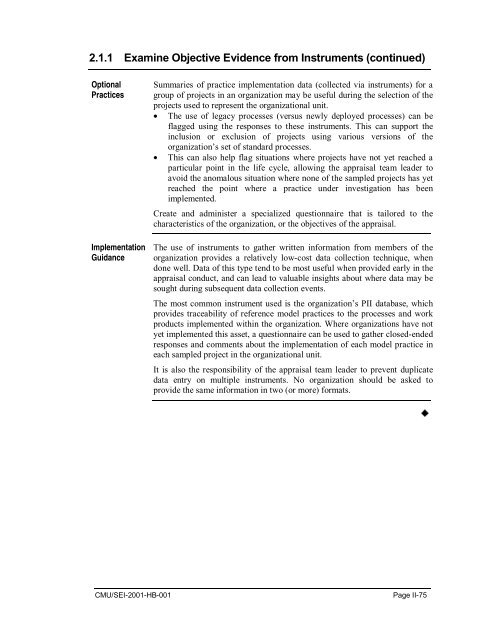Standard CMMI Appraisal Method for Process Improvement (SCAMPI)
Standard CMMI Appraisal Method for Process Improvement (SCAMPI)
Standard CMMI Appraisal Method for Process Improvement (SCAMPI)
You also want an ePaper? Increase the reach of your titles
YUMPU automatically turns print PDFs into web optimized ePapers that Google loves.
2.1.1 Examine Objective Evidence from Instruments (continued)<br />
Optional<br />
Practices<br />
Implementation<br />
Guidance<br />
Summaries of practice implementation data (collected via instruments) <strong>for</strong> a<br />
group of projects in an organization may be useful during the selection of the<br />
projects used to represent the organizational unit.<br />
• The use of legacy processes (versus newly deployed processes) can be<br />
flagged using the responses to these instruments. This can support the<br />
inclusion or exclusion of projects using various versions of the<br />
organization’s set of standard processes.<br />
• This can also help flag situations where projects have not yet reached a<br />
particular point in the life cycle, allowing the appraisal team leader to<br />
avoid the anomalous situation where none of the sampled projects has yet<br />
reached the point where a practice under investigation has been<br />
implemented.<br />
Create and administer a specialized questionnaire that is tailored to the<br />
characteristics of the organization, or the objectives of the appraisal.<br />
The use of instruments to gather written in<strong>for</strong>mation from members of the<br />
organization provides a relatively low-cost data collection technique, when<br />
done well. Data of this type tend to be most useful when provided early in the<br />
appraisal conduct, and can lead to valuable insights about where data may be<br />
sought during subsequent data collection events.<br />
The most common instrument used is the organization’s PII database, which<br />
provides traceability of reference model practices to the processes and work<br />
products implemented within the organization. Where organizations have not<br />
yet implemented this asset, a questionnaire can be used to gather closed-ended<br />
responses and comments about the implementation of each model practice in<br />
each sampled project in the organizational unit.<br />
It is also the responsibility of the appraisal team leader to prevent duplicate<br />
data entry on multiple instruments. No organization should be asked to<br />
provide the same in<strong>for</strong>mation in two (or more) <strong>for</strong>mats.<br />
<br />
CMU/SEI-2001-HB-001<br />
Page II-75
















